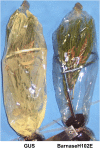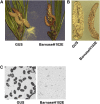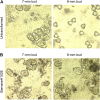Control of pollen-mediated gene flow in transgenic trees
- PMID: 22723085
- PMCID: PMC3425181
- DOI: 10.1104/pp.112.197228
Control of pollen-mediated gene flow in transgenic trees
Abstract
Pollen elimination provides an effective containment method to reduce direct gene flow from transgenic trees to their wild relatives. Until now, only limited success has been achieved in controlling pollen production in trees. A pine (Pinus radiata) male cone-specific promoter, PrMC2, was used to drive modified barnase coding sequences (barnaseH102E, barnaseK27A, and barnaseE73G) in order to determine their effectiveness in pollen ablation. The expression cassette PrMC2-barnaseH102E was found to efficiently ablate pollen in tobacco (Nicotiana tabacum), pine, and Eucalyptus (spp.). Large-scale and multiple-year field tests demonstrated that complete prevention of pollen production was achieved in greater than 95% of independently transformed lines of pine and Eucalyptus (spp.) that contained the PrMC2-barnaseH102E expression cassette. A complete pollen control phenotype was achieved in transgenic lines and expressed stably over multiple years, multiple test locations, and when the PrMC2-barnaseH102E cassette was flanked by different genes. The PrMC2-barnaseH102E transgenic pine and Eucalyptus (spp.) trees grew similarly to control trees in all observed attributes except the pollenless phenotype. The ability to achieve the complete control of pollen production in field-grown trees is likely the result of a unique combination of three factors: the male cone/anther specificity of the PrMC2 promoter, the reduced RNase activity of barnaseH102E, and unique features associated with a polyploid tapetum. The field performance of the PrMC2-barnaseH102E in representative angiosperm and gymnosperm trees indicates that this gene can be used to mitigate pollen-mediated gene flow associated with large-scale deployment of transgenic trees.
Figures







Similar articles
-
Pollen ablation of transgenic tobacco plants by expression of the diphtheria toxin A-chain gene under the control of a putative pectin esterase promoter from Chinese cabbage.Mol Cells. 1998 Jun 30;8(3):310-7. Mol Cells. 1998. PMID: 9666468
-
Functional characterization of a reproductive tissue specific promoter from Eucalyptus camaldulensis.Genome. 2018 Nov;61(11):777-786. doi: 10.1139/gen-2018-0106. Epub 2018 Oct 24. Genome. 2018. PMID: 30354691
-
Expression analysis of four Pinus radiata male cone promoters in the heterologous host Arabidopsis.Planta. 2003 Oct;217(6):858-67. doi: 10.1007/s00425-003-1057-9. Epub 2003 Jun 28. Planta. 2003. PMID: 12838419
-
Towards male sterility in Pinus radiata--a stilbene synthase approach to genetically engineer nuclear male sterility.Plant Biotechnol J. 2006 May;4(3):333-43. doi: 10.1111/j.1467-7652.2006.00185.x. Plant Biotechnol J. 2006. PMID: 17147639
-
Engineered selective plant male sterility through pollen-specific expression of the EcoRI restriction endonuclease.Plant Biotechnol J. 2016 May;14(5):1281-90. doi: 10.1111/pbi.12493. Epub 2015 Oct 26. Plant Biotechnol J. 2016. PMID: 26503160 Free PMC article.
Cited by
-
RNA interference suppression of AGAMOUS and SEEDSTICK alters floral organ identity and impairs floral organ determinacy, ovule differentiation, and seed-hair development in Populus.New Phytol. 2019 Apr;222(2):923-937. doi: 10.1111/nph.15648. Epub 2019 Jan 19. New Phytol. 2019. PMID: 30565259 Free PMC article.
-
Transcriptome Profiling Unravels a Vital Role of Pectin and Pectinase in Anther Dehiscence in Chrysanthemum.Int J Mol Sci. 2019 Nov 22;20(23):5865. doi: 10.3390/ijms20235865. Int J Mol Sci. 2019. PMID: 31766739 Free PMC article.
-
Strategies for Engineering Reproductive Sterility in Plantation Forests.Front Plant Sci. 2018 Nov 15;9:1671. doi: 10.3389/fpls.2018.01671. eCollection 2018. Front Plant Sci. 2018. PMID: 30498505 Free PMC article.
-
Development and characterization of transgenic dominant male sterile rice toward an outcross-based breeding system.Breed Sci. 2018 Mar;68(2):248-257. doi: 10.1270/jsbbs.17090. Epub 2018 Mar 24. Breed Sci. 2018. PMID: 29875609 Free PMC article.
-
Tree breeding, a necessary complement to genetic engineering.New For (Dordr). 2022 Aug 16:1-18. doi: 10.1007/s11056-022-09931-z. Online ahead of print. New For (Dordr). 2022. PMID: 35991378 Free PMC article. Review.
References
-
- Axe DD, Foster NW, Fersht AR. (1998) A search for single substitutions that eliminate enzymatic function in a bacterial ribonuclease. Biochemistry 37: 7157–7166 - PubMed
-
- Bramlett DL, Bridgwater FE. (1989) Pollen development classification system for loblolly pine. In Proceedings of the 20th Southern Forest Tree Improvement Conference. National Reforestation, Nurseries, and Genetic Resources (RNGR) Program, USDA Forest Service, Washington, DC, pp 116–121
-
- Bramlett DL, Williams CG, Burris LC. (1995) Surrogate pollen induction shortens the breeding cycle in loblolly pine. Tree Physiol 15: 531–535 - PubMed
MeSH terms
Substances
LinkOut - more resources
Full Text Sources
Other Literature Sources
Miscellaneous

